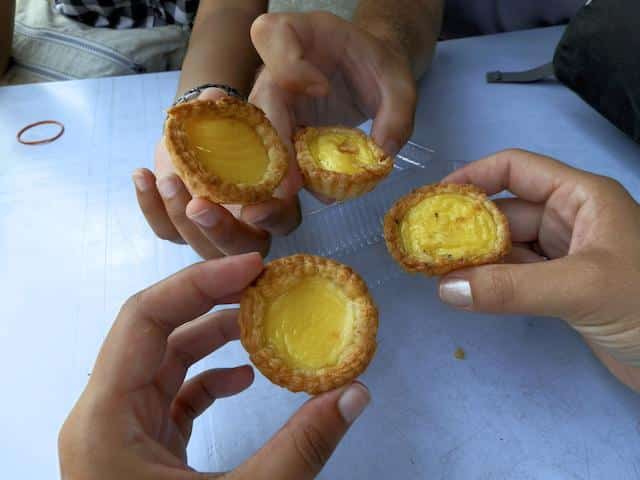One of the things that I find most interesting to learn on a trip is the history of the places I visit. No matter how much we study our whole lives, it is very different to see history being told through buildings, monuments and museums, rather than through the pages of a book.
It was only when traveling that I understood, for example, the extent of the Portuguese Empire and how they really influenced many cultures besides ours, at the time of the great navigations. Knowing I knew, but understanding and feeling it, was only when I set foot in places like Cape Town, Goa and Malacca.
 The Portuguese influence is so great that we find pastéis de Belém for sale in the street markets of Kuala Lumpur
The Portuguese influence is so great that we find pastéis de Belém for sale in the street markets of Kuala Lumpur
More or less 500 years ago, the Portuguese set sail from Goa with around 1200 men and 17 ships with the aim of conquering a strategic point on the Malay Peninsula, from where they could continue their expansion throughout the East Indies. There, they built forts and churches, spread their language and culture, expelled some sultans and, later, were expelled by the Dutch.
Many years have passed and today, the small port city of Malacca (in Malay, Melaka) is considered a World Heritage Site by UNESCO and the City of Culture and Colonial Heritage of Malaysia. The legacies, both from the Portuguese and Dutch eras, are visible at every corner.

The tour of Malacca begins at the Clock Tower square, where the Dutch left their mark with reddish-colored buildings. From there, you can walk to all points of interest in the city.


The Historic Center has an incredible number of museums, including an Islamic Museum and another focused on the architecture of the houses there. Unless you have a lot of time, you will have to select the ones that interest you most. We start with Maritime and Naval Museum. In the shape of a ship, the museum narrates the importance of Malacca as a port city and its influence on the local economy and culture. Expect to read a lot of Portuguese names during this visit.
 It's not a boat, it's a museum
It's not a boat, it's a museum
From there, we proceed to the St. Paul Church, a ruined church, built by the Portuguese in 1521 and from where you can have the best view of the city. The Porta de Santiago, what remains of the famous “A Formosa” fort, is another important attraction left by the Portuguese.
 Santiago Gate
Santiago Gate
The second museum we chose to visit was the Sultanate Palace, a replica of a 15th century Sultan's palace, built on the banks of a beautiful garden.
 Sultanate Palace
Sultanate Palace
But no visit to Malacca is complete without a stroll through Chinatown in the late afternoon. There you will find some Chinese temples, the best bars and restaurants in the region, as well as charming shops with all kinds of souvenirs and gifts you can imagine.

Tourist information about Malacca
How to get to Malacca
Buses leave Kuala Lumpur every hour and cost between RM$8 and RM$12 (R$5 and R$7.50). Local buses connect the bus station to Praça do Relógio for just RM1 (R$0.60). It is also possible to arrive by bus from the country's largest cities, in addition to Singapore. There is no train station in Malacca. The nearest is in Tampim, located 38km to the north.
How many days to stay
You can make Malacca just a day trip from Kuala Lumpur, arriving in the morning and returning at the end of the day, but if you have more time, it is advisable to spend a night there and enjoy the night in the charming Chinatown.
How much to spend
Between $25 and $30, including tickets and museum tickets.
Where to stay
If you chose to sleep in Malacca, the best place is in Chinatown.
Are you going to travel? Travel insurance is mandatory in dozens of countries and essential on vacation. Don't be left unprotected in Malaysia. See how to get insurance with the best cost/benefit for the country – and with a discount coupon.




